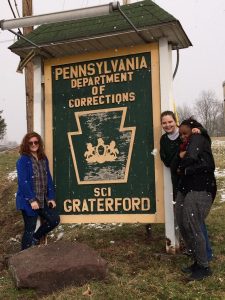Each year, a group of undergraduate and graduate students from Eastern Mennonite University studying restorative justice travel to Graterford State Correctional Institution in Pennsylvania for a unique opportunity to learn from incarcerated facilitators in the Alternatives to Violence Program.
“EMU’s relationship with Graterford is very unique,” said Gloria Rhodes, professor of peacebuilding and conflict studies who has accompanied the group several times. “We are very privileged to have this opportunity to interact with the men in the facility and learn from their experiences.”
Howard Zehr, a professor at EMU’s Center for Justice and Peacebuilding, made the initial connection between the university and the maximum security prison. In the early ’90s, Zehr created a program in which people serving life sentences met with families of homicide victims who wanted to engage in dialogue and ask questions. The result of this outreach was two books, each with photos and interviews: Doing Life: Reflections of Men and Women Serving Life Sentences (1996) and Transcending: Reflections of Crime Victims (2001). [A joint art showing combining these two projects with the work of CJP graduate students can be viewed here.]
The Alternatives to Violence Program began in 1975 as a collaboration between a group at Greenhaven Prison in New York and an area Quaker group. More than 1,500 incarcerated facilitators in 100 prisons work to transform their communities both while incarcerated and upon their release. In 2014, a total of 14,230 incarcerated citizens in the U.S. took the training in 2014.
Earl Zimmerman, assistant professor of Bible and religion, led the first trip of EMU students to Graterford in 2003. Three days are spent at the prison, participating in a variety of activities with incarcerated men that focus on community-building and communication skills.
This year, Adrienne Derstine, a student in Professor Johonna Turner’s “Restorative Justice and Trauma Awareness” course, reflected on her learnings about healing, community-building, alternatives to incarceration and conflict transformation.
Turner’s course, required in the criminology and restorative justice minor, explores core principles, values and practices of restorative justice in three major ways:
- as a framework for healing trauma and interrupting cycles of victimization and violence,
- as a component of a broader movement against racialized mass incarceration in the U.S., and
- as a set of principles and processes for building connection, repairing harm and maintaining positive relations.
To learn more about the criminology and restorative justice minor, click here.
Read student reflections on the 2012 visit and 2015 visit.
A Trip to Graterford: Searching for Justice and Hope
I’ve never given much thought to what it would be like sitting between prison inmates, but I certainly never considered it would include building play cars out of tinker toys or laughing about fads like dabbing while sitting in a maximum security prison.
Over spring break, 16 students were privileged to go to Graterford prison in Pennsylvania as part of the Restorative Justice and Trauma Awareness course taught by Dr. Johonna Turner.
The experience was rooted in the Alternatives to Violence Program (AVP), an educational curriculum devoted to restorative justice education within the prison system consisting primarily of interactive exercises portraying the importance of restorative practices and transforming power traits within all relationships, all conflicts, and within interactions.
One required text for the Restorative Justice course at EMU is The New Jim Crow by Michelle Alexander arguing that mass incarceration in the United States is the product of a racialized criminal justice system.
Rooting her thesis in a pertinent conversation through an extensive consideration of history it is undeniable that the current issue of mass incarceration is a system of racial control determined to silence people of color.
Society has the collective power to determine who has a voice, and while U.S. society silences those disadvantaged by the criminal injustice system, individuals with a voice must use it to speak out.
Despite the stereotypes of prison inmates as violent, harsh, and cold to the world, my experience of humbly holding stories about their their loved ones and witnessing their talents of writing, acting, ministering, and teaching demanded a changed perspective of who a prison inmate is.
Through the use of numbers and shaming tactics, the criminal injustice system attempts to negate the voice of valuable individuals, but programs like Alternatives to Violence focus on the humanity of people despite the choices they have made.
Overwhelming experiences such as my trip to Graterford engender feelings of guilt and helplessness, but in a society that rejects the incarcerated and people of color, paralysis is not an option.
However simplistic, my takeaway from this experience is to listen; not simply paying attention and nodding along, but deeply understanding and acknowledge the humanity in another through the profound process of listening.
Throughout the training it became clear that each resident participant exemplified valuable characteristics that have been suppressed through years spent in a dehumanizing system.
It might appear that locking people up is making society better, but without the voices of the talented individuals behind bars, society is losing far more than anything gained.
While listening seems minimal, genuine acknowledgement of the humanity of others can ignite passionate collaboration and embolden individuals to reach their full potential. Listening gives voice to the voiceless.
Without the contribution of all voices, we cannot expect creative solutions to the systemic problems plaguing society. So next time you are entrusted to hold the stories of another, listen.
